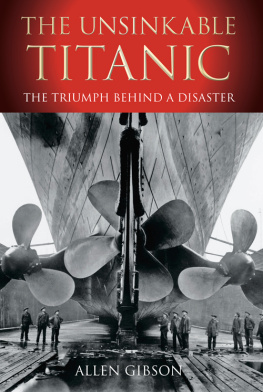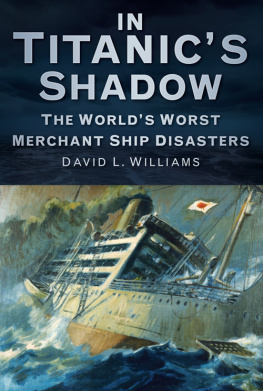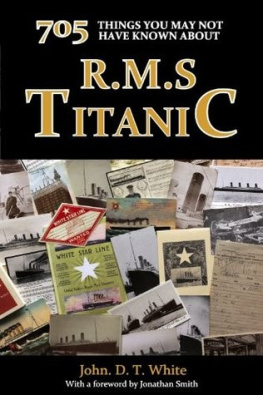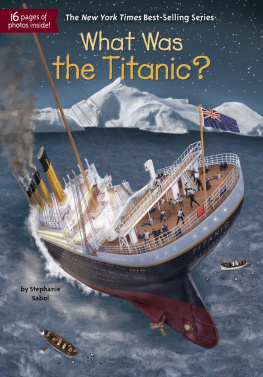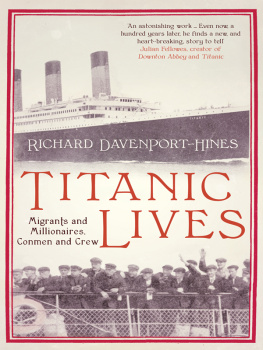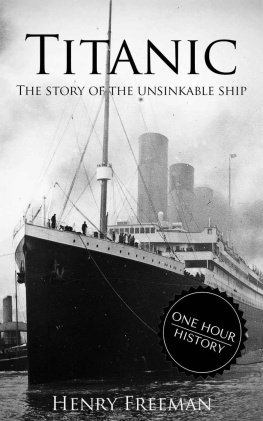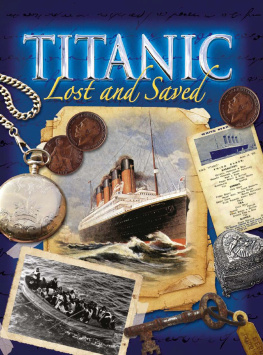

Titanic and Olympic were virtually identical. From the outset White Star marketed their brand as a byword for decadence in sea travel. Olympic with her Promenade Deck open to the elements was partially enclosed on Titani c to afford passengers shelter from sea spray. Titanic (right) pictured with her sister at Harland & Wolff in March 1912 prior to fitting the screens was built to embody the pinnacle of comfort at sea. ( National Museums Northern Ireland Collection Harland & Wolff, Ulster Folk & Transport Museum)
CONTENTS
Appendices
1 The Olympic Class of liners
2 Vessels nearest Titanic , 14 April, 11.40p.m.
3 Combined lifeboat provision and cubic capacities for Titanic
4 Daily mileage and average speeds of Titanic and Olympic during their maiden voyages
5 Survivals and deaths resulting from the Titanic disaster
Governance of Lifeboat Capacities
6 Capacities table: Merchant Shipping Act, 1894
7 Board of Trade Principal Officers review, February 1911
8 Board of Trade Principal Surveyors review, February 1911
9 Merchant Shipping Advisory Committee review, July 1911
10 Board of Trade Professional Advisors review, March 1912
11 Board of Trade capacities: review summary
12 Enacted revision of capacities table, January 1913
13 SOLAS revision, July 1915

In building the Titanic it was the hope of my associates and myself that we had built a vessel which could not be destroyed by the perils of the sea or the dangers of navigation.
Joseph Bruce Ismay, 21 April 1912
The summer of 2003 found me on a train bound for London to attend a Titanic artefact exhibition at the Science Museum. Heading there against my better wishes I was doggedly opposed to all the hype surrounding the show. Yet, burning curiosity had me standing in line eagerly awaiting my 11.30a.m. entry to the exhibits. With my White Star Line boarding pass in hand I wandered round the exhibition from one hall to the next, pausing by various meticulous arrangements of familiar items of salvage. Although outwardly aloof, secretly I was entranced by it all. The disaster that I studied so intently had with this visit suddenly transformed my solitary interest into an experience very striking, very real.
I began my research into the Titanic disaster in 1987 upon reading Robert Ballards book chronicling his discovery of the wreck. The encounter awakened a hunger that embarked me on a journey gathering material that before long transformed my bookshelves into a library devoted to Titanic . What a world I had discovered. I became a purist, growing firmly withdrawn from the increasing frenzy now usurping her legacy. Yet I found myself drawn to this exhibition, mesmerised by the allure of a ship none of us have seen nor would otherwise know of had she not encountered that infamous iceberg. Meandering around the exhibition, passing displays of silverware here, of playing cards and shoes there, these assortments of everyday once-personal possessions whose survival today owes itself to their presence on that tragic maiden voyage, resonated both awe and sadness for everyone to reflect at the enormity of loss in their time-frozen past. For the first time since my study began, Titanic was no longer the intangible monochromatic photograph I knew from my books.
I made a beeline for the exhibitions store. Shelves primed with all manner of glossy merchandising fridge magnets to reproduction chinaware I tried desperately to remain detached. I loathed the fickleness of sudden and promiscuous interest in my much-cherished passion; it being the latest merchandising fad, sensationalised to grab attention as if it was some fairground attraction. But for this day I was prepared to risk just that and finally meet face-to-face these treasures that once travelled on historys most fabled voyage. I comprehended then as I glanced at the faces of those about me, wide-eyed and venerating the exhibits as if sacred relics, Titanic had always been far more than a mere casualty of overconfidence. The experience found me realising that Titanic rests inextricably within our conscience. An existence so familiar that we recognise her silhouette long before discovering its detail. We intimately know of her plight without studying it. We will inherently forever know Titanic .
As I depart the exhibition my heart suddenly begins to race. I see a piece of hull visitors are allowed to touch. To the uninitiated, a nondescript shard of scrap, but seconds later I eagerly squeeze my finger through a tiny hole cut into its protective Perspex shroud, stretching to touch it. I am elated. I had made contact with Titanic a lifetime ambition accomplished. With this the exhibition comes to an end. However, there remains one final duty still to perform.
Each boarding pass handed out on entry bore the name of a Titanic passenger, and as I make my exit the reason for this becomes suddenly apparent: each visitor would adopt the name of that passenger and as a finale to the exhibition we search the lists of names of those who boarded the ill-fated voyage to discover our individual passengers fate. I was well aware of the math: the one in three chance of survival. It was sobering facts such as these that were the very reason I became drawn to Titanic , astonished how a ship of the twentieth century could brazenly head to sea carrying so few lifeboats, and discovering why its passengers would later willingly cede salvation in them. I yearned to discover how Victorian fastidiousness left this path to disaster so unguarded and if we, with modern hindsight, unjustly attribute her demise to ineptitude from management and navigation.
With a brief look at my boarding pass I peered up at the boards; the 2,000 names printed upon them invoked a poignant display. Eager to discover if mine was a millionaire industrialist or high-society luminary, I scanned the list. Almost believing the name on my card did not exist at all my eyes suddenly arrived at my passenger, a third-class migr. He had not survived. The game was an effective tool to bring home the reality that had all the people surrounding me travelled on Titanic , two thirds of us, including myself, would have perished. With mixed feelings I returned the boarding pass to my pocket and exit the museum, pondering how many others that day would bear the name of my passenger.
Like me, the multitudes converged and marvelled at these artefacts that had been heaved from the resting place of this terrible disaster. Yet this international fascination with Titanic will long surpass her physical existence, for these ever-swelling ranks of visitors and those of the generations following them, will all sedulously ensure that the name Titanic shall endure in the consciousness of humanity for evermore.
Allen Gibson, 2011

When anyone asks me how I can best describe my experiences of nearly 40 years at sea, I merely say uneventful I have never been in an accident of any sort worth speaking about. I never saw a wreck and have never been wrecked, nor have I been in any predicament that threatened to end in disaster of any sort.
Next page
